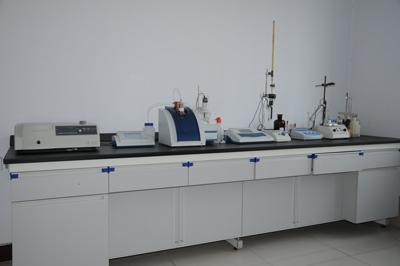The Classifications of Quaternay Ammonium Salt Bactericide
Quaternay ammonium salt bactericide, which has the property of ionic compound, is easy to dissolve in the water while it is hard to behave in the same way in the non-polar solvent, being stable in chemical property. The mechanism of action of this kind of bactericide is the cations to absorb bacteria with negative electricity through electrostatic force, hydrogen bond force and hydrophobic association between molecule of surfactant and protein molecule so as to push the bacteria to get together on the cytoderm and cause lysis and ventricular obstruction, leading to the death of the growth of bacteria due to inhibition. In the meantime, its hydrophobic alkyl group will react with hydrophilic group of bacteria to change the permeability of film, and then lysis happens to make bacteria dissolve and die. This kind of bactericide is high-efficient, non-toxic, no accumulation and moderately poisonous to fish, which is stand still when the pH changes. In addition, it is easy to use and it has rather strong peeling effect with characteristics including stable chemical property, dispersion and good corrosion inhibition.
Since 1935 when cationic surfactant could kill the bacteria, the fourth to sixth generations of quaternay ammonium salt bactericide products have been developed. The first generation was alkyl dimethyl benzyl chloride and HTMAC; the second was the derivatives of the first generation, which was obtained by means of the substitution reactions from bezene ring or quaternary nitrogen of quaternay ammonium salt; the third was dialkyl dimethyl ammonium chloride such as Di-sunflower dimethyl ammonium chloride; the fourth was the compound products of the first and the third generations; the fifth was bisquaternary ammonium salts like ethylene based double( dodecyl dimethyl ammonium bromide) that belonged to Gemini or dimeric surfactant.
Quaternay ammonium salt bactericide not only can kill the bacteria but has strong peeling effect on clay acting as a greenhouse for sulfate reducting bacteria which will be put to death. Also, corrosion inhibition will appear when it is used with other medicament. The common are 1227 ( dodecyl dimethyl benzyl ammonium chloride), 1231( dodecyl trimethyl ammonium chloride), bromo-geramine( dodecyl dimethyl benzyl ammonium bromide), 1427( tetradecyl dimethyl benzyl ammonium chloride), ethylene based double( dodecyl dimethyl ammonium bromide), and ethylene based double( tetradecyl dimethyl ammonium chloride), etc.
Biquaternary ammonium salts contain two hydrophobic groups, two hydrophilic groups and one linking group, whose creative structure will better its properties. The concentration of CMC is low that can lower the surface tension of water efficiently, increase the viscosity of solvent prominently and block the dirt and regulate pH. As for biquaternary ammonium salt, as its molecules become asymmetric, its positive charge gets more collectively and sterilizing effect becomes more ideal. On the contrary, if it is strong in molecular structure, the surface activity rises and the sterilization reduces. Biquaternary ammonium salts has better peeling effect. High-efficient bactericide named MQA made by Nanjing Tech University, Modification of fungicide metronidazole biquaternary ammonium salts named MBQA whose matrix is metronidazole developed by Huazhong University of Science and Technology and the one exploited by Tianjin Institute of Chemical Research and Design are asymmetric biquaternary ammonium salts.
Related News
 January 25, 2019Suspension dispersionThe process by which insoluble solids are dispersed into a solution to form a suspension with very small particles is called dispersion. The surfactant which acts to promote solid...view
January 25, 2019Suspension dispersionThe process by which insoluble solids are dispersed into a solution to form a suspension with very small particles is called dispersion. The surfactant which acts to promote solid...view January 25, 2019Foaming effectThe state in which the gas is dispersed in the liquid is called a bubble. If a liquid is easily formed into a film and is not easily broken, the liquid will produce a lot of foam when it...view
January 25, 2019Foaming effectThe state in which the gas is dispersed in the liquid is called a bubble. If a liquid is easily formed into a film and is not easily broken, the liquid will produce a lot of foam when it...view January 25, 2019Wetting effectWhen the solid is in contact with the liquid, the original solid/gas, liquid/gas interface disappears and a new solid/liquid interface is formed. This process is called wetting. For exam...view
January 25, 2019Wetting effectWhen the solid is in contact with the liquid, the original solid/gas, liquid/gas interface disappears and a new solid/liquid interface is formed. This process is called wetting. For exam...view November 15, 2018test test test test test test test test test test test test test test test test test test test test test test test test test test testview
November 15, 2018test test test test test test test test test test test test test test test test test test test test test test test test test test testview January 25, 2019Commonly used such active agents are fatty alcohol polyoxyethylene ether sulfate and sodium lauryl sulfate. The fatty alcohol polyoxyethylene ether sulfate is aliased to AES, sodium alcohol ether sulf...view
January 25, 2019Commonly used such active agents are fatty alcohol polyoxyethylene ether sulfate and sodium lauryl sulfate. The fatty alcohol polyoxyethylene ether sulfate is aliased to AES, sodium alcohol ether sulf...view January 25, 2019Toothpaste is comprised of powder abrasivus, wetting agent, surfactant, adhesive, spices, edulcorant and other special ingredient. 1.AbrasivusThe commonly used abrasives in tooth paste include:① Calc...view
January 25, 2019Toothpaste is comprised of powder abrasivus, wetting agent, surfactant, adhesive, spices, edulcorant and other special ingredient. 1.AbrasivusThe commonly used abrasives in tooth paste include:① Calc...view







 +86-153 1652 1570
+86-153 1652 1570  robert@blamine.com
robert@blamine.com
 126B 3#,No. 438 Xinnongpuyin Street, Zhujing Town, Jinshan District, Shanghai City, China
126B 3#,No. 438 Xinnongpuyin Street, Zhujing Town, Jinshan District, Shanghai City, China